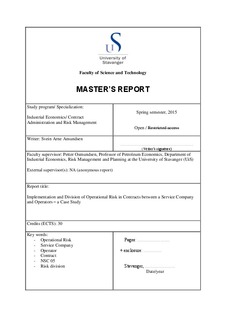| dc.description.abstract | In the recent years in the oil and gas industry, there has been an increased focus on risk management in the wake of accidents and unfortunate events involving material damages and/or personnel injury. The damage potential in the industry is particularly great during offshore operations, but also other stages in field development involve high risk situations which need to be managed and controlled. The stakes are high and the companies performing work in the sector are constantly looking for means of protecting their assets when being exposed to risk.
Offshore projects often demand substantial capital investments, several oil companies in joint ventures and the involvement of numerous service companies, to take the petroleum field from initial discovery to full production. This implies that there is a need for an extensive managing of the existing project interfaces, and to ensure an efficient division of liabilities, responsibilities and risk between the involved companies. The contract agreement between the various parties, with the contracts between the field operator and service companies in the centre of attention, is the foremost and most important tool for declaring the obligations of the parties. As such, it also dictates the risk exposure and the risk division that the respective parties have to relate to.
In this report, two different contracts between a service company (“Service Company”) and two of its customers, or field operators (“Company 1” and “Company 2”), will be analysed. The focus will be on how well the contracts implement and divide operational risk between the parties. Operational risk is understood here as the uncertainty-based risk exposure of an organization or company in its day-to-day activities, as discussed further in the report. The two contracts were chosen from the contract portfolio of the Service Company. Their contents were further analysed and compared with a standardized contract format, namely the NSC 05.
The findings in the analyses suggest that the concept of operational risk is not well implemented and shared in the contracts. There is of course an explicitly stated division of liability and responsibility between the parties in the contracts, as one should expect in contracts of this format. However, the lack of an explicit definition and thorough processing of operational risk in the provisions of the contracts, render it difficult to say that operational risk as a concept is consciously attended to and sufficiently implemented.
It is further recommended, based on this work, to investigate how to best implement operational risk in service contracts, to ensure a common understanding of the concept and to aid in an effective management of the risks involved in the contract work. | nb_NO |
